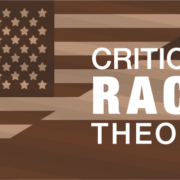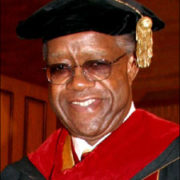Transfer leadership and management of Power 5 conference football* and Power 6 conference basketball^ to professional sports managers. Fans will still be able to root for their teams, pro-like sports will be overseen by pros, and higher education will rid itself of operating programs that no longer mesh with higher education’s mission and intent.
Let’s start with three basic questions: What is the purpose of higher education? What should higher education rank among its top priorities? On what priority items should higher education devote its resources? There is no way … it’s not possible … it’s ludicrous … it’s crazy … it’s the world upside down … to answer any of those questions with the words … college football and basketball … except in College Sports World, a world where winning, and winning consistently, are coins of the realm.
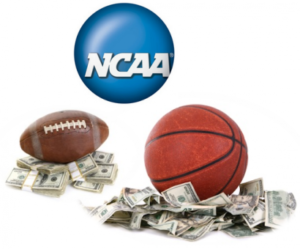
Courtesy: NewsBusters
Pay coaches mega-salaries. Put mucho bucks into facilities. Groom big donors. Hype the media. What’s more, fans love it, and many endorse doing what it takes to make their teams winners.
And what gets me especially riled up about what I’ve just described is that public institutions–those established by the public sector to serve the public good–are right in the middle of it. Heck, they are pack leaders. College coaches are the highest-paid public employee in most states and USAToday, which tracks the numbers, reports that just ten public universities–(familiar names that include Alabama, Michigan, Ohio State, Texas, Florida, and Georgia) spent a total of $1.5 billion on intercollegiate athletics last year.
Two hundred twenty other public schools spent about $11 billion more–including a good share of non-Power 5/6 programs that needed significant infusions from their general funds and student fees to pay athletic bills. The leader of that pack–Central Michigan–needed $55 million from those sources (85% of its total athletic budget) to balance its books. That, readers, is nonsense.
Many of us recognize–and some of us have experienced–the positive things that accrue from participating in intercollegiate athletics. But those benefits do not require being a participant in pro-like sports. Benefits are routinely made by the so-called ‘Olympic sports,’ that is, programs that don’t generate much, if any, revenue–sports such as golf, tennis, wrestling, cross-country, crew, and swimming/diving. But revenue-producing and non-revenue producing sports are not treated equally at America’s schools.
So when COVID inflicted a wallop on athletic budgets across the country, many school administrators eliminated non-revenue programs, including Michigan State, which cut the school’s men’s and women’s swimming and diving programs. And there’s a critical storyline associated with that particular cut because it demonstrates the nature of the problem. Both programs set a blistering pace in academics. Last year, the women’s program ranked #1 in the country among peers, and the men’s program was in the Top Ten nationally. The two programs contributed over 40% of all Spartan athletes who earned All-Big Ten academic honors. Gone.
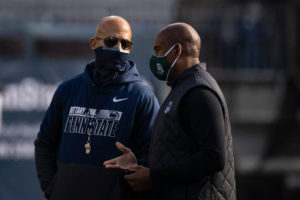
Franklin (left) and Tucker,
the $170 million men (photo, The Athletic)
Yet, that very same school just signed its football coach, Mel Tucker, to a $95 million, 10-year deal. And in College Sports World, a move like that ignites the next salvo in the financial arms race that is major college sports. Penn State countered Michigan State’s move by giving James Franklin a 10-year, $75 million extension. Liberty University —not even a school that plays in the heady echelon of Power 5 football—gave Hugh Freeze a contract extension that rivals what coaches earn in the Southeastern Conference. And you can bet your holiday cheer that more countering will follow.
That’s always the way it is in a College Sports World, a world without boundaries. Unlike the pros, there are no cap limits in major college sports. Get and spend as much as you can. The choice is yours. Result? It requires mo’ money and mo’ money to stay in the game, AKA, to remain competitive.
Tucker’s deal is no different, bankrolled by two mega-donors, endorsed enthusiastically by the school’s president, and praised by the school’s governing board chair.
The argument for it is simple: We have to do this. Otherwise…our coach will leave for another school. That would be a big mistake, a show of poor leadership, and an indication that we aren’t willing to do what it takes to compete with the best. And should an athletic director or president/chancellor call out this contract size as nonsense—as I am doing here–and even hint that the system is broken, you know what will happen. They’ll be gone. Their job is to lead what is, not question the status quo, call for reform, or (heaven forbid) act on it. Affirm the system and make us more competitive. That’s the contract.

The late T. Boone Pickens at Oklahoma State
(photo, Cowboys Ride for Free)
Another matter bears strong consideration—plutocrats reign supreme in College Sports World. Financial fat cats shovel millions into major college athletics, and with their ‘donations’ (and that’s what they are considered), they gain access and have influence. And why not? The deep pockets of the land know that without their money this doesn’t get done and that won’t get built. It’s called ‘leverage.’ But at what cost?
What the hell has happened to major, revenue-producing college sports? It got corrupted, that’s what. It’s a classic case of mission displacement–original purpose replaced by something else. And while I’m never surprised by how extensively other countries mimic things ‘American,’ major college sports are not one of them. No country has a major college sports system like ours. Not one. That’s because what I’ve just described isn’t considered a part of higher education overseas. That’s not what higher education is for. That’s not why higher education exists. Yes, they have intercollegiate athletics, just not the outsized kind, with Ohio State-Michigan or March Madness.
But what we have in America is not only mission displacement, it’s also corporate creep–the decades-long trend of public and nonprofit institutions (and that’s what they are, institutions) mimicking the business sector. The result? Public and private institutions have been reformulated, reorganized, newly evaluated, and consistently operated in a corporate-like manner, replete with corporate-like position titles (executive directors are now CEOs) and layers of administration (armies of VPs with many associates and assistants to the associates).
Then there’s salary bloat. The CEO of Blue Cross-Blue Shield of Michigan, a nonprofit institution, earned $11.5 million last year. Mel Tucker is in the same salary ballpark, and so are many other coaches. USA Today reports that the top ten football coaches are scheduled to earn nearly $80 million this year alone. USA Today also reported that the top ten compensated coaches in college basketball are scheduled to make $50 million this year. Those are pro-like salaries in sports that are pro-like offerings.
So, my proposal is simple. Transfer leadership and management of Power 5 football and Power 6 basketball to professional sports managers, namely, either the professional leagues (NFL, NBA) and/or other management professionals that meet the necessary standards. That way, we can continue to root for our teams, pro-like sports will be overseen by the pros, and higher education can rid itself of operating programs that no longer mesh with higher education’s mission or intent.
And you wouldn’t have to change team names, either. The Boston Celtics pro basketball team isn’t owned and operated by the City of Boston any more than the Seattle Seahawks pro football team is run by the City of Seattle. But both teams–and loads more–carry municipal names. The alternative–either naming a team after its owner or a company that owns a team–never works. How about the “Mara Family Giants” rather than the NFL’s New York Giants? Or what about “The Cincinnati Times-Star Cubs”, the initial owner of MLB’s Chicago Cubs?
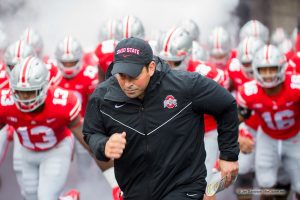
Courtesy: The Sporting News
So, why can’t we have professional sports management of the Ohio State Buckeyes, Oregon Ducks, Florida Gators, and Oklahoma Sooners? Each of those programs–let’s call them brands, too, because that is what they are–carry steep market value. Several years ago, the Wall Street Journal evaluated major programs and reported that several programs were estimated to be worth over $1 billion, with many other programs lurking in that neighborhood. Even the 50th ranked program (University of North Carolina) was worth an estimated $155 million. That market value gives universities considerable leverage in seeking prospective buyers and consummating favorable deals.
What would it take to turn over programs to the pros? Management entities would pay schools for the right to operate teams under the school’s banner and under conditions as prescribed by the schools, the conferences, and the NCAA. Players would sign contracts with the entities (they would be pro players) but not give up their right to enroll should they so desire. In exchange, schools would receive both a lumps sum and annual compensation to support their other sports programs and for other purposes as schools deem appropriate (e.g., academic scholarships, funding for faculty research, staff pay raises). In my proposal, schools would continue to lead/manage non-revenue producing college sports programs, and the NCAA and conferences would continue to exist, including oversight (in an ethical sense) over the full spectrum of college sports, including those run by management entities. A portion of the revenue arrangements accruing from the management entities would be funneled to the NCAA and athletic conferences to do their work.
But in making my proposal, I also need to say that it is not my first preference. But I believe it is the best available. Here’s why.
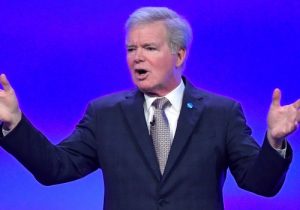
NCAA’s Mark Emmert doesn’t like my proposal,
and I can understand why (photo courtesy WOWK)
–I’ve given up on the NCAA leading the charge for reform. The NCAA is a membership organization that serves the universities and conferences. Insiders overseeing insiders never amounts to much of anything other than guarding the nest and protecting the status quo. And I’ll grant you this: the NCAA is a premier organization on both counts.
–I’m pleased that lawsuits are bringing change (such as NIL compensation for athletics), but those suits aren’t the proper avenue to achieve systemwide reform, and that’s what I’m after. My proposal, which ironically also includes compensation for naming rights, would. What’s good for the goose (athletes) is also good for the gander (institutions).
–I’m also pleased that elected Federal representatives have taken note. For years, House and Senate representations have lamented what college sports have become. Legislation has been proposed, including a College Athletes Bill of Rights, and regulating major college sports, just like any other major industry (major college sports is an industry). But America has loads of more critical issues, and that’s a big reason why Congressional action starts, sputters, and never gets to the finish line. Kudos, still, to Senators Booker, Blumenthal, and Murphy (most recently) and others (in the past), such as these U.S. House Representatives–Jim Moran, and Charlie Dent, Bobby Rush, and Joyce Beatty.

Photo by Jamie Sabau/Getty Images
and Saturday Blitz
–Finally, I’ve given up hope on getting s significant push for reform from fans—even those fans who are otherwise progressive in philosophy and temperament. That’s because even socially progressive thinking can be trumped by something else. Jane Coaston puts it this way: “Sports can make happy, well-adjusted people — human beings with jobs and dogs and kids and hobbies — lose their minds.” I’d put it more gently. College sports don’t get the same kind of attention as other issues because college sports aren’t often interpreted as ‘a social issue’ requiring reform. It’s entertainment, after all, and a way to express school pride. We all know that personal identities are tightly connected to collegiate affiliation. So when our college teams take the field or court, we vicariously run out with them. So, running away from your school–asking for change, pointing out issues–isn’t going to be a popular option. As Coaston points out in the same article cited above, fans tend to defend and deflect criticism of Alma Mater much the same way that many Democrats and Republicans protect their respective party. After all, Alma Mater is our party of affiliation.
That said, let’s get something straight: ‘Alma Mater’ means ‘Nourishing Mother.‘ But when it comes to revenue-producing major college sports–the College Sports World kind–I believe Mom needs big-time help. And, with all due disrespect, I think she’s doing a shitty job.
That said, alas, I think my proposal is DOA. What would it take? One way is for the NFL or NBA to start talking publicly about the desire to have a structural feeder system, like Major League Baseball has with the minor leagues. It could also happen if the next chapter in the evolution of College Sports World includes big-money athletic donors migrating from philanthropists to owners. One way to make my idea feasible is for friendly and trusted faces to run Alma Mater’s athletic programs.
In the meantime, if you believe, as I, that College Sports World can’t and shouldn’t continue as it is–and shudder to think what it will be like in ten years–here is something that you can do right now. Sign a petition.
I’m talking about the Drake Group’s proposal–and its plea to fans across the country–to join the organization in lobbying Congress to establish a Congressional Commission on Intercollegiate Athletics Reform. The Drake Group (disclosure, I am a member) makes it easy: GO HERE to read the proposal, fill in a few lines, and add your name to the petition. The mission of The Drake Group is to defend academic integrity in higher education from the corrosive aspects of commercialized college sports, and that’s why I am on board.
So, here is my plea: if you don’t like my proposal or the Drake Group option, then advance one of your own. Talk about it. Promote it with others. Do something. Don’t just sit there and cheer. It is possible — it’s feasible and reasonable — to be a fan and support major college sports reform.
Please don’t accept College Sports World as a given, something that’s normal and inevitable. It is neither. Remember the three questions: What is higher education for? What are higher education priorities? How might we best spend our resources?
(Hint: None of the answers should include reference to college football and basketball as played in College Sports World.)
________
*Power 5 conferences include universities associated with the Big Ten, Southeastern Conference, Atlantic Coast Conference, the Big 12, and the Pacific 12 Conference.
^The Power 6 conferences include all of the above plus schools affiliated with the Big East Conference.
